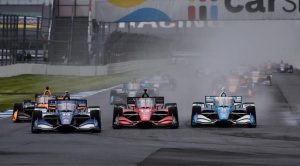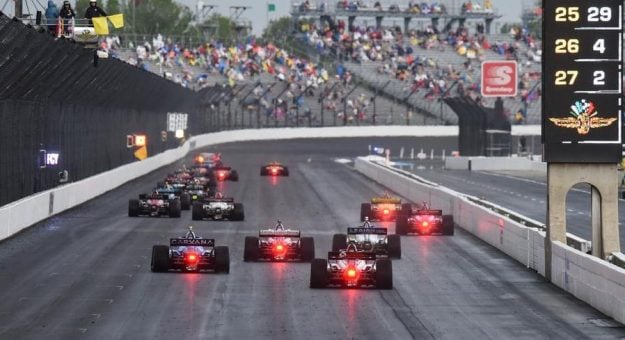INDIANAPOLIS — Saturday’s GMR Grand Prix on the Indianapolis Motor Speedway road course was the first time the cockpit protection system known as the aeroscreen was used in the rain.
The system was implemented on the Indy cars in 2020 and had been used on a wet track at Mid-Ohio Sports Car Course. But Saturday’s race was the first time it had been used in heavy rain and wet conditions.
Many drivers said at the end of the race, they simply could not see and relied on their spotters for instructions on when to turn the car to get through the turns.
“I’ve never seen anything like that before,” said Conor Daly after his fifth-place finish for Ed Carpenter Racing. “It was like the water just stayed in the center of the screen. I don’t know why, but even as you went faster, which you would hope it would clear, it didn’t. Again, I can’t say anything.
“Obviously, this is very much a scientific test run. Obviously, we have a lot of data to go through with the series and I’m sure Jay Frye (IndyCar President) will look at it as well. He hates when I talk about the aeroscreen, but I’m just describing what I saw. That’s all. It was challenging.
“Thankfully, we had a great spotter in Packy Wheeler, who was literally guiding me into turn one. I couldn’t see the brake zone or the cars in front of me or the end of the pit wall, but I could look out the side of the aeroscreen, so I was looking right and left to go straight, which was neat.”
Daly said it was a much different experience than racing in the rain in the open cockpit days when drivers were able to wipe away the rain and mist off their visor. The aeroscreen does not have a wiper blade system that is used on sports cars that race in the rain.
“Look, I used to race in the rain all the time, so we had a visor that you can work with, but this is a new era, so obviously there are things that we can figure out,” Daly explained. “We go from here.
“I do think it was tough. It was definitely hard to race like that because you don’t want to, obviously, end up on the wrong side. Even under yellow. I couldn’t see the cars in front of me under yellow. I had to be guided into pit lane, and that’s concerning. Hopefully we can figure that out, but hopefully we also have very shiny weather for the rest of the year.”
Simon Pagenaud of Arrow McLaren SP loves racing in the rain because it requires a different skill. He used all of those skills to race from 20th starting position all the way to a second-place finish.
For that aspect, he wishes there were more times IndyCar contests were conducted in the rain. Although he said he had some visibility issues at times, he didn’t belabor the issue as some drivers.
“I had visibility issues for sure,” he said. “A wiper would have helped. Obviously, I’m not an engineer. I don’t know what we should do.
“It’s certainly the first real test for the aeroscreen. It’s only been positive. I’m not being negative at all. I’m being quite positive about it and what we could do forward to make it even better.

“As we saw in Texas, it saved I think it was Callum Ilott, the wind screen saved him. That’s good, and we want to go forward from here. So, we’ll find solutions and improve it and make sure that when we have rain races, hopefully we have more, then we don’t have these issues.”
Third-place finisher Will Power of Team Penske said he couldn’t see a thing at the end of the race and the spray situation only got worse further back in the field.
“At the end there, man, you could not see a thing,” Power said. “There was a spray in front of me. I don’t know how it was behind the one car, but just the two car, I couldn’t imagine being back in 10th, man.
“You don’t know if someone is braking early or you are kind of looking to the fence to get a reference, you kind of lift early. You don’t want to lift too early because no one can see from behind.”
Pure rain was not the issue for visibility, but was when the track started to dry and grit, oil and other debris mixed with the rain created a haze on the aeroscreen.
“I didn’t have much problem with the rain,” Power said. “The worst part for me was when it was half wet. We’re on dries, and you have kind of that gritty just dirt on top of water. That was when I struggled to see a little bit, but in the full wet, I mean, the biggest problem for me was the spray from the cars.
“There’s really nothing can you do about that with open-wheel cars. It’s just going to be a lot of spray. Honestly, it was on the edge of whether we should have been running right at the end there. It was starting to get a bit of aquaplane.”
Before the aeroscreen, drivers would get soaked in the cockpit during a rain race. According to Power, however, the aeroscreen kept the drivers relatively dry inside the car as the rain was deflected over the opening on top of the screen.
